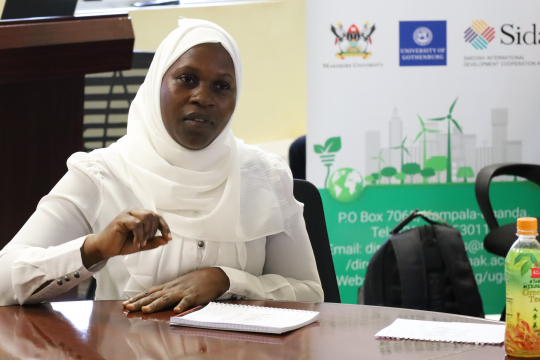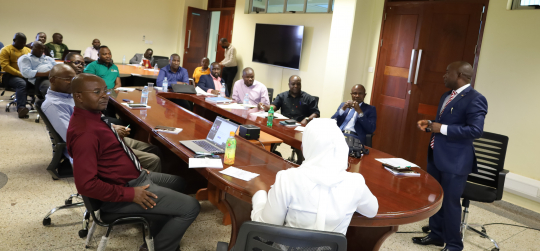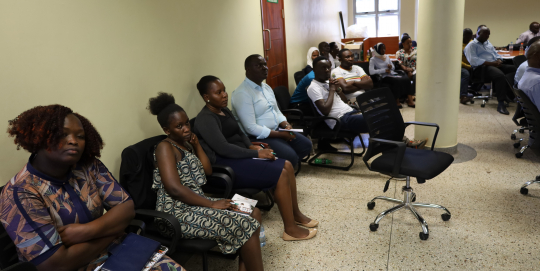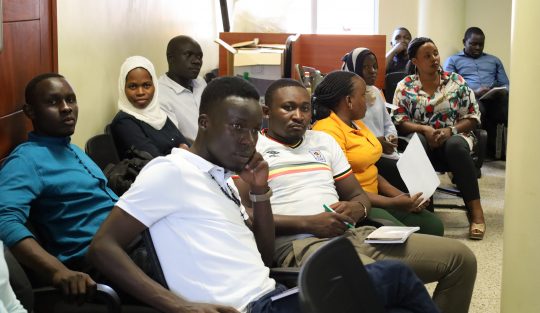A study conducted by researchers at EfD-Mak Uganda has shown that Chapati vendors could only afford to use the Liquefied Petroleum Gas (LPG) cookstoves in their households. The study findings indicated that LPG cook stoves were more expensive than using charcoal in such small businesses.
The study also revealed that Chapati vendors demonstrated considerable credibility in settling installments and that appropriate terms and access to hire-purchase schemes can support the adoption of cleaner and modern cook stoves by food vendors.
The study titled, Purchase and Learning Schemes and Adoption of LPG Cook stoves: Experimental Evidence from Uganda, was funded by Sida under the auspices of the EfD network at an estimated budget of US$ 55,747.
The project was launched on 18th August 2021 under the leadership of Dr. Aisha Nanyiti assisted by three Co-PI’s Professor Fred Matovu, Dr. Suzan Kavuma, and Richard Ssebagala, School of Economics, Makerere University.
Disseminating the study findings, on 13th October 2022, Aisha Nanyiti noted that biomass is the predominant energy used for cooking by households and food vendors in Africa. In Uganda for instance, biomass constitutes 94% of the energy used whereof fuel wood represents 64% and charcoal 30%.
She reported that reliance on biomass increases the deforestation rate and contributes to climate change. The 44 million tons of tree biomass that are used per year in Uganda impose negative health effects with respiratory infections accounting for 18% of all illnesses in Uganda with women facing a higher risk of illness.
Various interventions have been undertaken to promote the use of cleaner cooking technologies. Earlier studies focused on improved cookstoves while some studies asses LPG cookstoves.
These studies focus on the adoption of and attitude towards LPG and identify barriers as high initial cost, limited supplies, and perceptions. The high initial cost is especially relevant to adoption by low-income groups where subsidization is not sustainable.
“Hire-purchase schemes are relevant to easing the high initial cost. These have not been assessed before. Most studies focus on households. This study assesses the impact of hire-purchase schemes, learning schemes, on the adoption of LPG cookstoves by chapati vendors,” Aisha Nanyiti said.
The study employed a Randomized Control Trial with chapati vendors in the capital Kampala in three divisions of Kampala, constructed three clusters of parishes in each division, and implemented three treatment arms in each division (treatment 1 information only, treatment 2 information + hire-purchase and treatment 3 information + grace period learning+ hire-purchase.
The treatments were administered to individual owners at their chapati stalls. From each cluster 100 chapatti vendors were randomly selected. Five surveys were conducted, baseline, intervention, first follow-up, second follow-up, and end-line. The intervention was conducted at the stall in teams of two and vendors always carried the full kit of LPG cook stove to the stall.
“In treatment 1 (information only) the research team offered verbal information on the benefits of using LPG cookstoves and offered an opportunity to buy the LPG cookstove by paying at once the full cost of UGX 210,000 ($60). This opportunity lasted for two weeks and the vendors refilled gas cylinders themselves at a nearby refill station.
In treatment 2 (information and hire-purchase) the research team provided verbal information on the benefits of using LPG cookstoves and the vendors were offered the opportunity to buy the LPG cookstove on a hire-purchase in 3 installments (70,000 ) or 4 installments (50,000 ). The vendors had an opportunity to instead pay at once. The opportunity lasted for two weeks and vendors had to refill the cylinders by themselves at a nearby refill station.
In treatment 3 (information + grace period learning+ hire-purchase) the team provided verbal information on the benefits of using LPG cookstoves, offered an opportunity to use the LPG cookstove for two weeks then decide to buy the LPG cook stove on a hire-purchase basis or to pay at once. The opportunity lasted for two weeks and the refill was done by the vendors themselves at a nearby refill station. But on returning, vendors would pay 49,000 for the gas used.
In the information-only treatment zero vendors bought the cook stove nor tried it out. In the hire-purchase treatment 5 vendors decided to try out the cook stove, 60 vendors decided to try out the cook stove and 87 out of 250 decided to try it out. Trying out the cook stove is highly correlated with buying the cook stove.
Of the 92 vendors who decided to try out the cook stove, 60 vendors decided to buy the cook stove, 29 decided to return the stove but 3 disappeared with the stoves. One vendor used the pay-at-once scheme, 8 vendors paid in three installments and 51 vendors chose the four installment payments.
Performance in settling installments
29 vendors after the intervention paid the full installment, 22 paid on average two-thirds and 7 vendors returned the cook stove after paying the first installment while 2 vendors disappeared after paying the first installment.
If any investor is to take up this kind of scheme, they need to know how vendors are settling their schemes.
Impact of the schemes
The hire purchase scheme had a significant effect on the decision to buy the LPG. The learning scheme also had a significant effect in terms of increased buying of the LPG. The vendors bought the cook stoves but did not use them at the stalls instead for households.
The learning treatment has a significant effect on vendors having LPG as their main alternative energy source in the household.
Those who returned the stoves said it was more expensive than using charcoal, was risky, and not viable in windy weather. Some complained about a lack of working and storage space some feared the LPG could be stolen and the landlord refusing them to use LPG.
Conclusion
Vendors demonstrated considerable credibility in selling their installments and given the appropriate terms of access to hire-purchase can support the adoption of LPG as an alternative cleaner cooking energy source.



